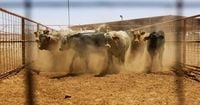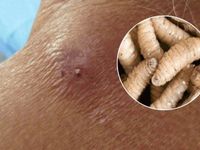Authorities in Chiapas, Mexico, have confirmed two human cases of myiasis caused by the screwworm of livestock, Cochliomyia hominivorax. This alarming development, reported on May 7, 2025, has raised health alerts, particularly in rural areas where the risk of infection is heightened due to close contact with livestock.
The first case involves a 50-year-old man from Tuzantán. After being bitten by a dog, he noticed symptoms four days later, including intense pain, redness, fever, and the alarming sight of live larvae emerging from the wound on his left leg. He sought medical attention at the Huixtla Health Center, where six larvae were extracted. The diagnosis was confirmed through taxonomic analysis by the National Service of Health, Safety and Agri-Food Quality (Senasica).
The second case is a 77-year-old woman from Acacoyagua, who presented a serious wound on her skull measuring approximately 3x3 centimeters, with exposure of bone. She is currently receiving treatment at the High Specialty Regional Hospital Ciudad Salud in Tapachula, where she is stable and undergoing antibiotic treatment and disinfection measures.
Myiasis is a parasitic infection caused by larvae that feed on living tissue, and while it is more common in livestock, humans can be affected, especially in areas with poor sanitary conditions and a high presence of infected animals. The larvae emerge from eggs deposited by flies in open wounds or mucous membranes, and can cause severe infections if not detected early.
Between November 2024 and April 2025, Senasica documented a staggering 869 cases of myiasis in animals across southeastern Mexico, with Chiapas accounting for more than half of those cases at 487. Other affected states include Tabasco, Campeche, Quintana Roo, Yucatán, and Oaxaca. The rise in animal infections significantly increases the risk of transmission to humans, particularly in rural communities where interactions with livestock are frequent.
Health authorities have activated protocols to manage this unusual parasitic infection. The Ministry of Health has emphasized the importance of maintaining proper hygiene in wounds, covering them adequately, and avoiding contact with infected animals. They have also implemented strategies including epidemiological surveillance, the use of larvicides, and public awareness campaigns in affected areas.
In response to this outbreak, the Ministry of Health has initiated standardized procedures for monitoring myiasis cases in humans. These measures include swift identification and disinfection of infested wounds, timely reporting to health jurisdictions, and the collection of biological samples for entomological analysis.
As health officials work to contain the situation, they urge the public to be vigilant and seek immediate medical attention if they suspect an infection. Symptoms of myiasis can mimic those seen in animals, particularly when larvae invade natural cavities of the body. The most common form in humans is rhinomyiasis, which affects the nasal cavities, but larvae can also compromise other structures, including the palate and even the skull.
In addition to the two confirmed cases of human myiasis, authorities have reported the first case of infection in animals in Oaxaca, where a horse was found to be affected. This further highlights the need for ongoing monitoring and preventive measures to protect both livestock and human populations.
As the situation develops, health authorities remain on high alert, reinforcing their commitment to public health safety and the prevention of further infections. The community's cooperation is crucial in these efforts, particularly in rural areas where the risk is most pronounced.
The emergence of these cases serves as a stark reminder of the interconnectedness of animal health and human health, underscoring the importance of maintaining rigorous health standards in agricultural practices. With the potential for outbreaks to escalate, continued vigilance and proactive measures will be essential in safeguarding both livestock and human populations from the threats posed by parasitic infections.





